Animals in Contemporary Architecture and Design
DOI: https://doi.org/10.52537/humanimalia.9628
Jennifer Wolch is Professor of City and Regional Planning and the William W. Wurster Dean of the University of California-Berkeley College of Environmental Design.
Email: wolch@berkeley.edu
Marcus Owens is a PhD candidate in Landscape Architecture and Environmental Planning at the University of California - Berkeley College of Environmental Design. He is trained as an architect and co-founder of design research studio CAMO projects, and is an affiliate at the Berkeley Center for Science, Technology, Medicine and Society.
Email: mowens@berkeley.edu
Humanimalia 8.2 (Spring 2017)
Abstract
What are animals doing in design? How do designers see, care for, and use animals? In this paper we analyze an array of design projects featuring animals, identifying intersections between human-animal studies (HAS) and design studies, and discussing the broader social significance of the figure of the animal or animality in design. First, we review the literature at this convergence between these two fields. Next, we discuss the results of our snowball survey of animal design projects across several prominent design blogs. We consider the distribution of attention designers delegate to certain animals, the standardization of certain animal designs, and which designs circulate in the design public sphere, revealing cultural blind spots and biases of designers. Finally, this paper asks how animal design tactics highlight broader social transformations related to the mobilization of perception, behavior and desire as technical practices with functional outcomes. This paper argues that the study of design as a hybrid aesthetic and technical practice yields unique insights both into studies of technics and technology as well as human-animal relations. This paper proposes such a view helps frame both studies of design as well as human relations with nonhuman animals more broadly.
What are animals doing in design?
To answer this question, we analyzed a small sample of contemporary animal design projects, taken both from the oeuvres of established practitioners as well as one-off projects and competition entries circulating on design culture media platforms. In doing so, this paper also considers what it means to pose such a question, located at the intersection of human-animal studies (HAS) with its attention to relations between humans and animals, and design studies, whose focus is on technology, material and visual culture. While Matthew Fuller has examined art for animals, and DiSalvo and Lukens attempt to make sense of a broader “non-anthropocentric design,” this research more specifically follows Sloterdijk’s “rules for the human zoo,” proposing the intersection between these domains as increasingly politically pertinent for humans, given market-driven advances in biotechnology and the relationship of design to the libidinal late-capitalist economies of attention, creativity, and innovation. This research suggests that the aesthetic practice of design provides an ideal forum for bringing the question of animality and desire into studies of technics and technology. Likewise, technical aspects of design provide a means to understand animals beyond innate morphological essences assigned by humans, from an ethological perspective composed of expressions of movements, sensations, and environmental flows (Parikka xxv).
In the cases of both animal and design studies, there is already evidence of trajectories towards convergence. Given its roots in the animal rights and liberation movement, and predicated on growing scientific evidence of nonhuman subjectivity, HAS has particular relevance in the contemporary moment, in which resilience politics and the perception of ecological crisis underpin a de-centering of the human. More recently, some propose to reconfigure notions of agency and subjectivity to accommodate beings beyond the charismatic animals that have dominated 20th century animal studies and its humanist rights-based approach, including fungi (Tsing), mosses (Gabrys), and even the “inhuman” geologic matter of the cosmos (Barad). These approaches may incorporate aesthetic and semiotic theory to expound upon the potential political agency of materials. Without necessarily committing to Latour’s project of assembling a “parliament of things,” these literatures are worth noting in the way that they bring materials into animal studies, providing a window to connect with design studies as a material practice. While animal advocates may clash with a bio-centric environmentalist outlook on issues such as the extermination of certain species for the sake of biodiversity metrics, the general, if at times ambiguous, goal of raising awareness of a nonhuman-other can often constitute the ends for sustainability-minded animal designers.
To begin to place animals in design, we must first understand design’s historical relationship to technology, and to material and visual culture. Across theories of design in domains from anthropology (Ingold), to philosophy (Flusser), to histories of technology (Marx) and art (Coles 8), design is understood as a way of making and doing that emerges from the broader classical Greek techné associated with the practical, manual labor of slaves and peasants. For these scholars, design becomes distinct from technology and the broader techné with the division of labor associated with Taylorist industrial production. Ingold describes how the emergence of design and other “spontaneous work of the human imagination” such as artistic or scientific genius, act as an antipode to technical practices resulting from the rise of machinic labor and the decline of the artisan (295). For scholars of material culture and technology, design refers to the curatorial or aesthetic arrangement of materials or technologies (Bijker et al.). In this way, the “work” of the designer is this added curatorial or aesthetic labor that extends beyond the immediate material functionality of the technology itself.
However, design is also distinct from the modern concept of art, underscored by Renaissance concept of disegno and Rancière’s “aesthetic regime,” or art. Formulated at the close of what Rancière terms the “representative regime,” disegno, or the act of drawing, serves to negotiate the interface between art and technology, or creative vision and manual labor in the modern era (Ross 4). In this way, design must, or at least should, theoretically “work.” This technical sense of producing predetermined outcomes is in contrast to the autonomy afforded to art under the aesthetic regime that defines modernity. Design is expected to produce novel, iconoclastic, and/or destabilizing scenarios or products, yet at the same time requires at least some level of consensus and functionality.
One way of discussing animal design projects in our survey is in terms of this relationship to material functionality and aesthetics. Largely resulting from academic studios, ideas competitions, and art practices, many projects featured on blogs such as BLDGBLG, its Future Perfect affiliates, and Expanded Environment, are more critical or speculative in nature. While they are sometimes elaborations on established typologies, such as a “future zoo,” they also feature forms other than traditional animal typologies, thereby imagining new material components for novel interspecies relations. These projects blur the boundaries between art and design in different ways. “Critical design” (Malpass) or “design art” (Coles) practices create objects whose “function” is often critique or provocation, something other than what is literally implied by design. Speculative designs, emerging from academic studios, and think tanks draw on a long tradition in architecture of imagining visionary, alternative realities or critiquing existing ones is a hallmark of modern design. Finally, the phenomenon of the starchitect is also clearly rooted in the modernist cult of genius associated with the aesthetic regime of art rather than an emergent or evolutionary perspective. Many of the built projects featured on design sites — especially zoos and aquaria — relate more to a conception of architectural practice as brand-building in the contemporary moment. Many of the built animal architecture projects on Archinect, Archdaily, Designboom, and Dezeen tend to be aestheticized neo-modernist iterations of these standardized typologies dictated by industry standard guidelines, rather than “designing for animals” per se.
Whatever the form, this characteristic of design for controlled innovation neatly corresponds to late-capitalist modes of accumulation. If the deep-time, atmospheric- science, and post-equilibrium paradigms of ecology present a planetary reconfiguration of ideas about the environment, media theorists argue for a dissolution of the division between bios and techne through concepts such as bio-media (Thacker) or wetware (Winthrop-Young) systems that triangulate with software code and hardware devices. Considering the power dynamics of “designerly ways of intervening into people’s lives” (Markussen), or the “engineering of affect” (Julier; Thrift) implicit in design, the notion of “atmospheric power” emerges to describe how the organism’s sensorium becomes the subject of design in the constant production of novelty, innovation, and brand management required to capture consumer attention in the contemporary attention economy (Borch et al.). If genetic material, living cells, and neurons are the frontiers of a new wave of “techno-primitive accumulation” (Preciado), examining the role of animals in design allows us to understand the dynamics of animality in contemporary designs for humans. For example, how might thinking about animals and animality help scholars of technology and design think about our relation to machinic intelligence, such as the mechanical turk, artificial intelligence, or fashion and makeup design to avoid facial recognition software?
A Study of Animals in Design: Methods and Materials
To begin to get an overview of contemporary design for animals, we conducted a targeted search of design-culture media for projects referencing animals. This search was largely web-based, as architecture projects, both built and speculative, are not published in ways comparable to books, peer reviewed journal articles, or even popular publications. This can be due to professional non-disclosure agreements with clients, as well as the vast array of competitions, exhibitions, academic studios, and other speculative work that circulates ephemerally in, and in many ways defines, architecture and design culture today. Our survey therefore focused on the so-called “blogosphere” of prominent architecture web-blogs, including Archinect, Archdaily, Designboom, Dezeen, BLDGBLG and its Future Perfect affiliates. Inhabitat, a more consumer-oriented eco-lifestyle design blog, also featured some animal architecture projects. Finally, the blog Expanded Environment (formerly Animal Architecture) is wholly devoted to animals in architecture and design culture, and has organized several “Animal Architecture Awards.” The following discussion of the species distribution uncovered in our search therefore corresponds to a wider body of scholarship visual and media studies addressing the algorithm habitats of charismatic digital animals (or charismatic starchitect brands)* (Lorimer; Rothfels; Lippit).
Species Representation
All in all, our search included a suite of weblogs and traditional publications, including books, journals, and exhibition catalogs dating from the year 2000 to 2014. In Linnean terms, of the 86 projects considered, two deal with mollusks, 12 with arthropods, and 72 with vertebrates (we found no projects that explicitly dealt with annelids, sponges, or jellyfish). Of the 12 arthropod projects, seven are bee projects, concerned with an animal whose relation to technology is also subject to numerous scholarly investigations (Kosek; Parikka). Four of these bee projects were variations on a bee hive, a type of project addressed here as a decorative variant of animal housing. Other designs included an ecological project that aims to assist bees in pollination, and two were projects that exploit the tendency of bees to produce honeycomb structures. The two mollusk projects found in our query were Natalie Jeremijenko and Chris Woebken’s “mussel choir” and SCAPE Landscape Architect’s “Oystertecture” proposal for New York Harbor.
By far the largest group is designs for vertebrates, despite being the phylum with the least number of individuals. Of the 72 vertebrate projects, 12 deal with bats and/or birds, and all but two of these are housing for either wild animals or domestic chickens. As with the designer beehives, while these projects in some sense prefigure contemporary ecological and urban wildlife designs, they often appear to be less “design for animals” that engage with animal sensory capacities than decorative iterations of existing typologies. Similarly, many of these designs for vertebrates also fell into established typologies, such as the veterinary facility or the zoo, each with its own set of industry-standard best practices, discussed later.
Of the vertebrate projects, designs for companion animals such as dogs and cats were very common. There were 12 projects for dogs or cats, seven companion-animal veterinary care facilities, three companion-animal housing schemes, and two dog parks. Not included in this companion-animal count was one project featuring experimental fish bowls, which joined a total of six underwater, marine, or aquarium projects. A subset of these care facilities for companion animals is a proliferation of designs for companion species that go beyond the threshold of standard veterinary care and into the realm of luxury, and signaling human social status such as in Meier Moh Architekten’s “Canis Resort.”
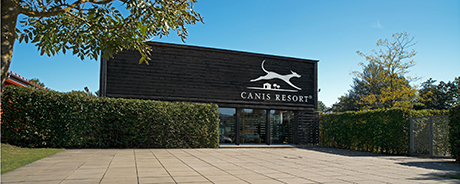
Figure 1: “Canis Resort” (von Meier Architekten)
Dogs have long been the focus of studies of human-animal relations, given their evolutionary attunement to human affect, emotion, and ways of life. This has ranged from archaeological and zoological (Serpell) to more ethnographic (Haraway; Thomas) analyses of human-dog relationships, while geographer Heidi Nast has criticized the contemporary material culture of these relationships as symptoms of “neoliberal alienation. A history of this genre of design might include Ohlone Park in Berkeley, California, which claims to be the home of the United States’s first dog park, established in 1979. Other projects uncovered in our Internet search included the dog playground “City Dog Adventure” in the Netherlands by Maarje Dros, and East River Waterfront dog park by Ken Smith.

Figure 2: “City Dog Adventure” (Maartje Dros)
Additionally, there were numerous takes on the dog-house typology, including the starchitect exhibition “Architecture for Dogs,” and Cubix’s “Dog House.”
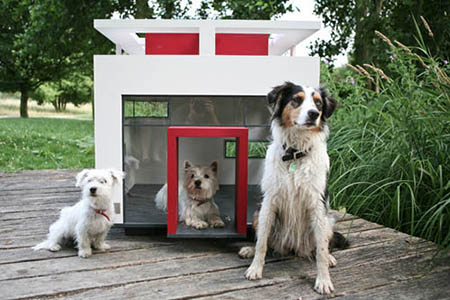
Figure 3: “Dog House” (Cubix)
Thought in terms of design, these projects may have more in common with the decorative beehives and bird and bat houses. There were many designerly bird and bat houses, ranging from high-end fabricated objects to the wildly speculative, such as Zhong Huang’s “Birdscraper.”
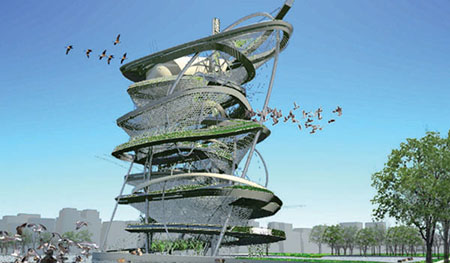
Figure 4: “Birdscraper” (Zhuong Huang)
A variant on these companion-animal and animal-care projects is the wildlife rehabilitation facility, a typology associated with practices and technologies of restoration ecology or its more extreme variant, “rewilding.” The ethics of wildlife reintroduction and behavior modification are the subject of philosophical debate by environmental ethicists such as Clare Palmer. Practical methods for wildlife reintroduction as part of restoration ecology are still emergent, subject to the formation of norms and best practices. They therefore provide more space for design intervention (Harrington et al.). For the most part, projects found here were closer to refuges or veterinarian facilities. While many of these projects were nonetheless skillfully executed designs, intersections between the emerging fields of wildlife reintroduction and landscape restoration may be ripe for further innovation through the integration of technologies of rehabilitation, incubation, and behavior conditioning with the broader landscape-scale restoration and corridor plans discussed previously.
By framing these projects in Linnean terms we are able to see which types of animals receive the most attention from human designers. As might perhaps be expected, it is the vertebrates, not the far more numerous arthropods. Interestingly, those animals often said to be our evolutionary closest relatives, great apes, received no attention, while companion animals such as cats and dogs receive a substantial amount. Similarly, livestock animals that produce milk or are consumed directly by humans also receive almost no attention.
Best Practices and Speculative Provocation
Another way to parse these findings is to differentiate between built and unbuilt projects, or provocations and critiques made using nonhuman animals and realized projects of more conventional animal-building typologies. A large share of the projects featured on architecture blogs were iterations of established animal typologies: zoos, aquaria, veterinarian facilities, refuges, and wildlife rehabilitation centers. As with many of the designer birdhouses and beehives, in these built projects design does not engage with the animal her/himself, but rather functions as a means of human distinction. For example, PR materials for a luxurious veterinary facility or petting zoo usually obscure standard cages, operating equipment, and other nonhuman animal interfaces. In many cases, professional guidelines and affiliations exist. For example, the National Institute of Building Sciences has a Whole Building Design Guide for Vivaria; the National Institute of Health’s Office of Research Facilities has guidelines for the design of animal research facilities; the World Association of Zoos and Aquariums maintains an index of animal exhibit design and construction projects; and the North American Veterinary Community features sessions on design in recent conferences. These professional protocols and best practices form the basis for conventional, “everyday” animal architectures, and often form a distinct sector of the design services industry. For example, according to the Whole Building Design Guide, vivaria, like non-animal research facilities, must contain high performance Heating Ventilating and Air Conditioning (HVAC), promote cleanliness, and facilitate biosecurity protocols. Additionally, vivaria must accommodate the appropriate “cage sizing and cage systems” according to the National Research Council’s Guide for the Care and Use of Laboratory Animals, which in turn dictate room size, environment, and circulation patterns. Because of the controversial nature of animal research, extra security and confidentiality are also pertinent to design. In our search to find documentation of vivaria, we found they were conspicuously absent from the plans of prominent life-sciences university research facilities featured in architects’ portfolios. However, industry sources such as Laboratory Design News feature practical design products for use in animal research, such as Coulbourn Instruments’ “Small Animal Treadmill,” “suitable for forced exercise training and muscle fatigue studies.” In this way, the opacity of architectural design contrasts with the visibility necessary for design and sale of products that populate the lab.
Similar to the invisibility of vivaria, in the case of the slaughterhouse architectural design obscures human vision, countering what Timothy Pachirat describes as “a space of exception.” While the obscuring of vision translated to a dearth of designs for vivaria, projects engaging with animals through food production constituted a significant portion of projects. However, while many projects pertain to practices of confined livestock housing and care, few focus on the design of slaughterhouses and the act of slaughter itself — perhaps the most notable exception being the work of Temple Grandin.
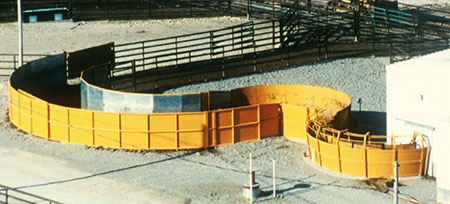
Figure 5: Slaughterhouse Gangway (Temple Grandin)
Among all the livestock design projects, both speculative and applicable (at least conceptually), one can make a broad differentiation between techno-visionary projects and those that seek a more pastoral, locavore sensibility. Fabricated farm projects in the survey that retain more of a back-to-the-land, urban homesteading orientation included Mike Meiré’s “Farm Project,” presented at Design Miami in 2008, 70F’s “Petting Farm” in Almere, Netherlands, and a host of objects for urban homesteading fabricated by New Orleans based CrookedWorks.

Figure 6: Farm Project (Mike Meire)
Examples of the former include theoretical projects such as the MVRDV “Pig City” project, a conceptual design to produce enough pork to satisfy the Dutch Market as efficiently as possible. The project is at once grotesque and also an effective critique of meat consumption and national sustainability politics.

Figure 7: “Pig City” (MVRDV)
A more recent speculative project, “Farmland World” by Chicago-based Design With Company, presents a techno-futuristic urban pastoral reminiscent of Andrea Branzi’s “Agronica,” a project that landscape theorist Charles Waldheim references to argue that the contemporary convergence of design and agriculture is a result of increasing environmental literacy amongst designers.
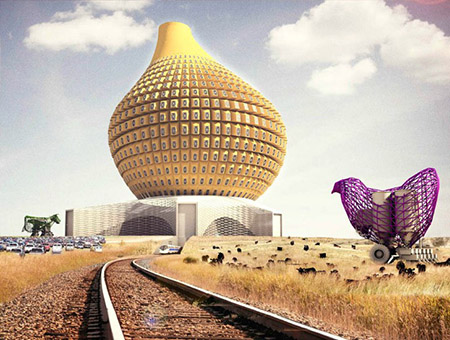
Figure 8: “Farmland World” (Design With Company)
Waldheim suggests that this interest encompasses the production and distribution of food in a globalized world, as well as the benefits of pre-industrial farming techniques such as biodiversity and ecological sustainability. More broadly, Waldheim promotes the discipline of landscape urbanism as a means to apply lessons from ecology informed by complex systems theory as a departure point, with landscape emerging as a preeminent medium for design. In this way, many of the animal-design projects in this study bear this influence beyond the scope of agriculture.
Encountering Animals in the Designed Landscape
While Frederick Law Olmsted deployed grazing livestock in projects like New York City’s Central Park as part of the pastoral ambiance of the landscape garden movement, an “ecological turn” in the mid-1970s repositioned nonhuman animals in the landscape from a perspective informed by endangered-species legislation and biodiversity-driven conservation biology. Within North-American landscape and environmental design culture, these strategies are often associated with the use of the “overlay technique” and ecological assessment surveys in the design and planning process that reconfigure landscape as habitat. As outlined in their 1998 Animal Geographies, Wolch and Emel observe that the contemporary “greening” of architecture and design has occurred in tandem with the maturation of urban ecological science to incorporate human-impacted urban ecosystems, while emergent late-20th century urban morphologies seem to allow more and more large fauna to come into close contact with humans. Many of the projects highlighted below function to smooth out these points of contact within the urban fabric.
These larger scale projects are often calibrated around a metric of biodiversity, or with the goal of protecting or recreating habitat connectivity for large keystone predators. Derived from principles of applied conservation biology and restoration ecology practice, examples of these large-scale plans include the Florida Wildlife Conservation Corridor, the Dutch National Ecological Network, and the proposed Yellowstone-to-Yukon Wildlife Corridor. Within these larger regional plans are landscape-scale design interventions, such as wildlife crossings and habitat restoration. While designers are largely absent from the Florida plan, several high profile Dutch design firms have built wildlife overpasses in the Netherlands, and the ARC Wildlife Overpass in Vail, Colorado was the product of a large international competition, won by Michael Van Valkenburg Associates “Hypar-nature” proposal.
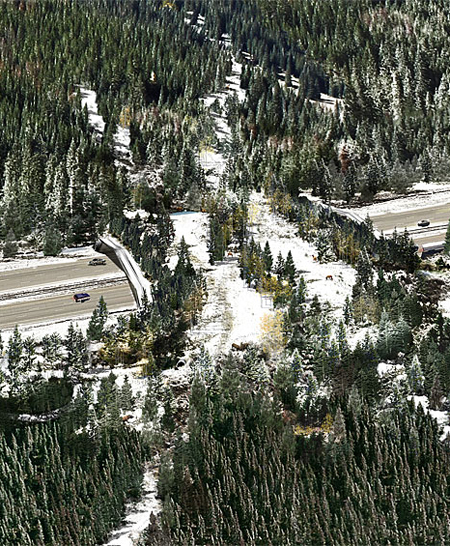
Figure 9: “Hypar-nature” (MVVA)
Other landscape plans and designs not necessarily part of a larger regional connectivity scheme may nevertheless include habitat restoration for specific species as a key part of the design. With complexity theory shifting focus from a balance of nature to optimizing energetic flows through a system, lines between habitat restoration and agriculture can blur. SCAPE Landscape Architecture’s entry into MOMA’s Rising Currents exhibition consisted of a series of oyster beds to detoxify seawater and mitigate rising sea levels associated with climate change.
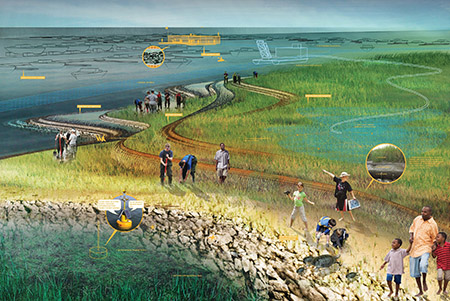
Figure 10: “Oystertechture” (SCAPE)
In addition to SCAPE’s multi-functional infrastructure project, Hung’s honorable mention “Urban Transhumance” in the 2012 Animal Architecture Awards is another notable food-producing landscape-scale project.

Figure 11: “Urban Transhumance” (Kyunglin Hong)
One notable difference between these and restoration ecology projects driven by conservation biology is the de-centering of a native species and biodiversity metrics in favor of metabolic performance.
While not on the landscape scale, among the most practical developments in smoothing out animal encounters with the infrastructures of urban development may be mitigating bird-kill collisions that come with steel-frame glass-curtain wall construction (Klem). Architect Jeanie Gang has been especially prolific at designing bird-friendly high rises, such as her “Aquatower” in Chicago.
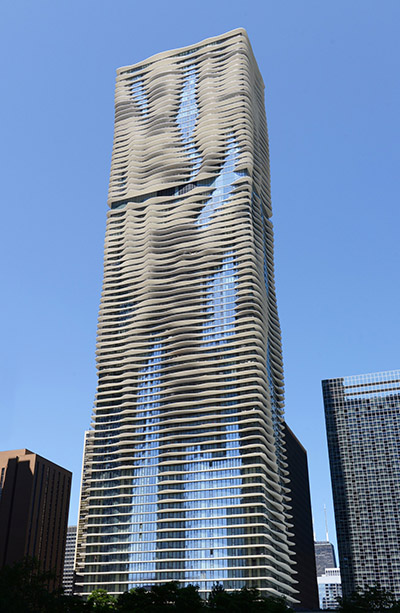
Figure 12: “Aquatower” (Studio Gang)
Similar tactics are employed at her Ford Calumet Environmental Center on Chicago’s de-industrializing south side. However, what is perhaps most notable about the Environmental Center is its function. Between designs that preserve biodiversity, maintain ecosystem services, and produce food on the regional or landscape scale, are numerous designs for facilities such as the Calumet Environmental Center, which enable people to watch or otherwise safely encounter urban wildlife.
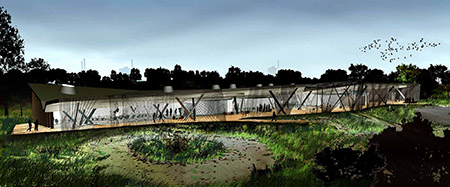
Figure 13: Lake Calumet Environmental Center (Studio Gang)
These projects tend to oscillate between those that seek to reconfigure or reimagine entire landscapes, versus those that deploy positioning devices or architectonic interventions such as a variety of prompts, signs, viewing platforms and other tactics to design the experience of an existing landscape. The notion of seeing animals in the wild also extends underwater in Promontorio Architecture’s More River Aquarium in Portugal, as well as Jeanne Gang’s plans to reconfigure the Baltimore Aquarium as something more akin to a sanctuary.

Figure 14: Mora River Aquarium (Promontorio Architecture)
In one sense, wildlife-observation structures may be seen as somewhat analogous to the decorative birdhouse. Adhering to a sort of naturalist-relational aesthetics, many tend to operate within the modernist metaphor of alienation from nature, ignoring the constant interspecies becoming that is part of being human, and fixating on an encounter with a charismatic animal other or “native species” as a stand-in for broader more-than-human ontology. These projects are often accompanied by ecologically informed theoretical mission statements about facilitating cross-species care, though many are more sculptural and gestural than practical. Projects fabricated for design biennales and exhibitions can make the goal of “creating habitat” for urban wildlife seem dubious. Naturalist-relational aesthetics often entails the use of scientific language, such as “native species,” as part of the aesthetic form, or the boast of collaboration “in dialog” with wildlife experts. However, in the worst cases adopting the language and prerogatives of conservation biology can further obscure the production of scientific knowledge as an apolitical “black box.” This is especially evident in projects that fixate on the idea of native species, which some consider a racialized historical concept of questionable practical utility.
However, it is worth taking seriously the means through which we watch and encounter other animals. Just as in the case of vivaria and the slaughterhouse, design as an aesthetic or sensory practice directly engages with the politics of visibility. From this frame, rather than decorative symbolic objects, an example of interesting wildlife housing and designs for encountering animals is Austin’s bat bridge. The world’s largest urban bat colony, with 1.5 million roosting bats, is tucked under the Congress Avenue Bridge in downtown Austin, Texas. Each night they eat from 10,000 to 20,000 pounds of insects. The evening bat flights have become a major tourist draw, with an estimated 100,000 people visiting the adjacent Statesman Bat Observation Center to observe the bats (www.batcon.org). Here, it is not presumed that the bats need housing constructed for them (they found the bridge). Rather, the invasive bats, minding their own business, are re-branded and designed as a site of interest and a source of local identity, rather than a pest to be exterminated.
Of course, when it comes to watching animals the preeminent architectural types are the zoo and the aquarium. Within the domains of architecture and design, zoos may be the typology with the most established body of critical and historical literature. Animal historians have written extensively on 19th-century zoos, menageries, and stables, as part of imperial nation-building, modernization, and urban development (Ritvo; Anderson), while others have focused on the zoo as a philosophical project (Acampora). Jeffrey Hyson has written specifically on this history of zoo design in America. Some spaces, such as elements of the London Zoo, are part of broader design histories (Anker), while Cedric Price’s work in the London zoo has been the focus of Hadas Steiner.
Our research yielded many built zoos, as well as speculative ones. Of particular note are the plans for BIG Architect’s “Zootopia,” which is under construction in Denmark. The diagrammatic visuals and unrelenting iconoclasm for “Zootopia” are classic BIG, and what is notable is the utopian language that attempts to rework the zoo as a landscape experience.
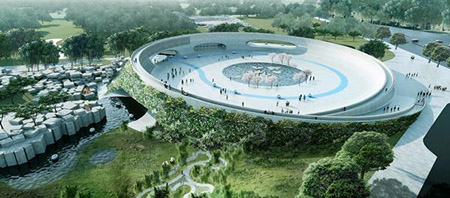
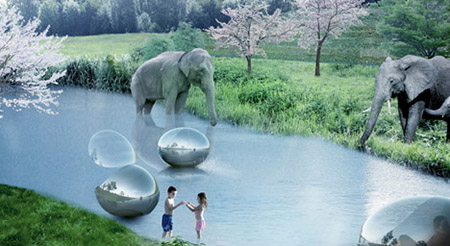
Figure 15 & 16: Givskund Zoo (BIG)
However, despite the requisite iconoclastic hype that comes with BIG’s branding, much of what they propose, conceptually, are standard protocols for zoo design, and already in play at the Givskud Zoo, with its “Safari” layout. These tactics were pioneered by mid-century Swiss ethologist and de facto zoo designer Heini Hediger’s work on social, critical, and flight distance in getting animals to reproduce and live full lives in captivity. These strategies have had a lasting impact on architecture and environmental design that is still felt today, as space is increasingly designed to produce value through predetermined cognitive outcomes in domains such as shopping and user interface or experience design (Pine and Gilmore; Underhill). Surely, BIG is accelerating these techniques in innovative ways, but most pertinent to BIG’s design for the sake of our discussion is the dynamics at play in the Givskund Zoo, the sort of ethological perspective whose form is produced by expressions of movements, sensations, and environmental flows that constitute the animal body.
Operationalizing Umwelt: Animal Skeuomorphs
This ethological perspective on the animal has roots in proto-ecologist Jakob von Uexküll’s Umwelt Theorie and the subsequent field of bio- or eco-semiotics. For Uexküll and his followers, Umwelt describes a species or organism-specific model of the world, corresponding to a given creature’s sensorium. This understanding has been adapted in ecology as the idea of “continua” in conservation practice. Here, landscape connectivity is seen from an “umwelt” perspective based on species-specific affordances, rather than simply in terms of habitat restoration based on a remotely sensed “view from above,” as in post-war landscape ecology (Manning and Lindenmayer). This perspective leads us to a final category of design for animals that is less of a scalar or programmatic typology than design tactics or a mode of design production. In each of these projects, designs harness nonhuman animal bodies, abilities, or behavioral tendencies in an Uxeküllian semiotic Functionskries, or “functional circle” between organism and environment.
These designs cast animals in performative roles through engaging with an animal’s perceptual capabilities. First, a suite of designed objects aestheticize engagement and interaction with urban wildlife in ways other than housing. These projects operate on the level of specific interactions rather than the broader, coarse grain of principles for architectural or landscape best practices. Natalie Jeremijenko and Chris Woebken, both as collaborators and independently, have produced a wide variety of transspecies work that fits this category. Most famous perhaps is their “Amphibious Architecture” project, which attempts to enable fishes in New York’s East River to communicate with humans ashore.

Figure 17: “Amphibious Architecture” (Natalie Jeremijenko & Chris Woebken)
Their designs for a “Bat Billboard,” as well as Anne Galloway’s “Counting Sheep,” propose a similar broadcasting of information from nonhuman-to-human, via digital sensors. While not involving animals per se, Chris Woebken’s “Animal Superpowers” design, as well as Simone Farrecina’s 2011 Animal Architecture Awards Winning “Theriomorphous Cyborg,” both draw on the resurgence of Uexküll’s work in prompting humans to speculate on the other worlds sensed by nonhuman animals. However, as “critical design” or “design art,” many of these designs operate in a sphere closer to art practice, where material functionality is less clearly articulated. Clearly, the prefix critical pertains to the way these designs are meant to provoke, bringing the issue of functionality into question in a way that sets them apart from our focus on architecture and landscape designs.
While it is beyond the scope of this paper to enter a debate around the functionality or performative capacities of critique, it is worth noting how projects that attempt to extract information from the animal Umwelt for aesthetic consideration by humans are distinct from a class of designs that harness these modes of perception as a means of production. Here, we propose the use of the concept of the animal skeuomorph to describe the design elements at play. This concept originates in archeology to describe representations of non-functional elements derived from functional elements of a previous design iteration; one classic example of a skeuomorph being etchings on a clay pot that refer to a woven basket. Steve Jobs and Apple brought the skeuomorph concept to prominence in user interface design (UIX) with a famous example being digital representations of analog clocks. In this context of UIX, skeuomorphs accelerate human comprehension of new designs. In the case of non-human animals, we use the term to describe the mobilization of animal perception and behavior to produce results desired by human designers.
A prime example of this is the MIT Media Lab’s Mediated Matter Research Group’s recent 2013 “Silk Pavilion.” One of five non-bee arthropod projects, a robotic arm creates a lattice by weaving a thread around a geodesic dome framing structure. Silk worms are then placed on the thread to complete the fabrication of the dome, as they produce silk fibers along the thread as part of their life cycle. The result, unbeknownst to the worms, is an ethereal, silk cover for the dome.

Figure 18: “Silk Pavilion” (MIT Mediated Matter Group)
Heralded by Geoff Manaugh of BLDBLG as “Animal Printheads,” the dome is still somewhat of a conceptual aesthetic practice (the dome is displayed in a lobby at MIT) rather than an actual building technique, but its value is located in material production, not (only) critique.
While such techniques may be considered novel in their relation to emergent technologies and scientific knowledge, Calhoun reminds us that technology often serves simply to allow us to do things we already do a bit more easily. In this sense, these animal-informatic designs represent an end point of a much longer history of human-animal relations defined by tracking and following other animals. Strapping cameras onto pigeons or translating fish or bat behavior into text messages are in some ways fundamentally analogous to the early hominid strategies of reading the behavior of other animals in the landscape to aid in the search of water or food. As this eventually developed into the human “art of tracking” (Liebenberg), Sanford Kwinter describes these increasingly sophisticated tactics of reading signs of other organisms in the landscape, accompanied by encephalation, as the origins of a science of the environment from which architects and designers continue to draw. From this perspective, we can begin to see technology as bound-up in evolutionary processes as suggested by paleontologist Andrei Leroi-Gourhan.
Conclusion
Critical or functional, technologically sophisticated or traditional, humans’ designs for other animals instrumentalize nonhumans by appealing to specific aspects of their physiological capacities, some in more productive ways than others. In addition to isolating these sign relations and describing them in semiotic or Uexküllian fashion, we can also analyze the economy of these projects, considering the politics of animal participation and the ways animals are cast as unwilling, and perhaps unaware, labor. From one perspective, because designs are for human purposes, we can only assume ends are calibrated to human values and politics. What qualifies as a “good,” “interesting,” or “innovative” design that capitalizes on the physical exertion of animals? In this light, the most successful animal designers are those that acknowledge the lives of the common and quotidian animals in our midst, and integrate animal subjectivity into contemporary practices, while also executing a novel technical outcome. A prime example might include Jeanne Gang’s integration of bird friendly building skin technology as one of many innovative features in her “Aquatower.”
Reviewing these designs for nonhumans yields insights into human politics and the power of design therein. Using the example of BIG’s Givskund Zoo and their move away from the caged animal, design begins to fade into the background, while subtly managing animal affect and behavior towards specific, functional outcomes. Such an invisible zoo seems to come full circle to urban wildlife projects discussed earlier, where the planetary scale of urbanization transforms the globe into a managed sphere, and wildlife migration routes are subject to design. If the modern slaughterhouse corresponds to industrial modes of accumulation and labor relations characterized by the discipline of the factory floor and the jail cell, the most sophisticated contemporary designs for animals tend to operate in the register of Umwelt, or a functional combination of perception and affect reflected in emerging technologies of wildlife reintroduction, the skeuomorphic MIT silkworm pavilion, or distilled into market driven bio-info-cogno-technologies. To a more extreme extent, one can see this logic at play in bio-engineering projects of Terraform 1, such as their living “In-vitro Meat Habitat” concept.

Figure 19: “In-vitro Meat Habitat” (Terraform 1)
In this way, thinking about the regimes of control and productive capacities of animals in contemporary design may find fruitful insights from feminist notions of affective labor and autonomist Marxist theory deployed to understands the dynamics of the attention economy and the “new spirit of capitalism,” where creativity (or creation) becomes a functional outcome of design (Boltanski and Chiapello; Lordon). In this regard, a study of animals in design suggests designers ought to treat their subjects with compassion, as their worlds are also subject to management through design. Moreover, as the world becomes increasingly designed, some argue the capacity for alternative and unforeseen uses diminishes as technology specifies pre-determined outcomes (Redström). The fact that we are living through the sixth great extinction in the earth’s history attests to this dynamic, as well as the proliferation of design. When creativity and creation become specified by design, thinking about the way we design for other animals reveals the interplay between biological and technological evolution more broadly. In this regard, we might think carefully about who receives design attention, how much, and for what ends.
Note
Using the internal search feature on each blog powered by Google should also be considered in relation to the “politics of the search” outlined by Rogers and others. While beyond the scope of this discussion, the politics of the search is directly related to the engineering of affect in which design practice is implicated.
Works Cited
Acampora, Ralph R. Metamorphoses of the Zoo: Animal Encounter after Noah. Lexington Books, 2010.
Anderson, Kay. “Animal Domestication in Geographic Perspective.” Society & Animals 6.2 (1998): 119–35.
Anker, Peder. “Science in Culture: Bauhaus at the Zoo.” Nature 439.7079 (2006): 916–916.
Barad, Karen. “Posthumanist Performativity: Toward an Understanding of How Matter Comes to Matter.” Signs 40.1 (2014): 801-31.
Bijker, Wiebe E., Thomas P. Hughes, Trevor Pinch, and Deborah G. Douglas. The Social Construction of Technological Systems: New Directions in the Sociology and History of Technology. MIT press, 2012.
Boltanski, Luc, and Eve Chiapello. “The New Spirit of Capitalism.” International Journal of Politics, Culture, and Society 18.3–4 (2005): 161–88.
Borch, Christian, Gernot Böhme, Olafur Eliasson, and Juhani Pallasmaa. Architectural Atmospheres: On the Experience and Politics of Architecture. Walter de Gruyter, 2014.
Calhoun, Craig. “Community without Propinquity Revisited: Communications Technology and the Transformation of the Urban Public Sphere.” Sociological Inquiry 68.3 (1998): 373–97.
DiSalvo, Carl, and Jonathan Lukens. “Nonanthropocentrism and the Nonhuman in Design: Possibilities for Designing New Forms of Engagement with and through Technology.” From Social Butterfly to Engaged Citizen. Eds. Marcus Foth, Laura Forlano, Christine Satchell, and Martin Gibbs. MIT, 2012. 421-435.
Flusser, Vilem, and John Cullars. “On the Word Design: An Etymological Essay.” Design Issues 11.3 (Autumn 1995): 50–53.
Fuller, Matthew. “Art for Animals.” Journal of Visual Art Practice 9.1 (January 1, 2010): 17–33.
Gabrys, Jennifer. “Becoming Urban: Sitework from a Moss-Eye View.” Environment and Planning-Part A 44.12 (2012): 2922-39.
Grandin, Temple with Mark Deesing. Humane Animal Handling: Understanding Animal Behavior and Building Facilities for Healthier Animals. Storey Publishing, 2008.
Haraway, Donna J. When Species Meet. U of Minnesota P, 2008.
Harrington, Lauren A., Axel Moehrenschlager, Merryl Gelling, Rob PD Atkinson, Joelene Hughes, and David W. Macdonald. “Conflicting and Complementary Ethics of Animal Welfare Considerations in Reintroductions.” Conservation Biology 27.3 (2013): 486–500.
Hyson, Jeffrey. “Jungles of Eden: The Design of American Zoos.” Environmentalism in Landscape Architecture. Michel Conan, Ed. Dumbarton Oaks Research Library and Collection, 2000. http://scholarship.sju.edu/hist_fac/1/.
Ingold, Tim. The Perception of the Environment: Essays on Livelihood, Dwelling and Skill. Psychology Press, 2000.
Julier, Guy. “From Visual Culture to Design Culture.” Design Issues 22.1 (2006): 64–76.
Klem, Daniel Jr. “Collisions between Birds and Windows: Mortality and Prevention (Colisiones de Pájaros Con Ventanas: Mortalidad Y Prevención).” Journal of Field Ornithology 61.1 (1990): 120–28.
Kosek, Jake. “Ecologies of Empire: On the New Uses of the Honeybee.” Cultural Anthropology 25.4 (2010): 650–78.
Kwinter, Sanford. “Combustible Landscape.” Projective Ecologies. Chris Reed & Nina-Marie Lister, Ed. Actar, 2014. 336-53.
Leroi-Gourhan, Andrei. Gesture and Speech. Trans. A. Bostock Berger. MIT Press, 1993.
Liebenberg, Louis. The Art of Tracking, the Origin of Science. International Publishers Marketing, Inc., 1990. http://ir.nmu.org.ua/handle/123456789/133244.
Lippit, Akira Mizuta. Electric Animal: Toward a Rhetoric of Wildlife. U of Minnesota Press, 2000.
Lordon, Frédéric. Willing Slaves of Capital: Spinoza and Marx on Desire. Verso Books, 2014.
Lorimer, Jamie. “Nonhuman Charisma.” Environment and Planning D 25.5 (2007): 911.
Malpass, Matt. “Between Wit and Reason: Defining Associative, Speculative, and Critical Design in Practice.” Design and Culture 5.3 (2013): 333–56.
Manning, Adrian D., David B. Lindenmayer, and Henry A. Nix. “Continua and Umwelt: Novel Perspectives on Viewing Landscapes.” Oikos 104. 3 (2004): 621–28.
Markussen, Thomas. “The Disruptive Aesthetics of Design Activism: Enacting Design Between Art and Politics.” Design Issues 29.1 (December 12, 2012): 38–50. doi:10.1162/DESI_a_00195.
Marx, Leo. “‘Technology’: The Emergence of a Hazardous Concept.” Social Research 64.3 (Fall 1997): 965–88.
Nast, Heidi J. “Loving…. Whatever: Alienation, Neoliberalism and Pet-Love in the Twenty-First Century.” ACME: An International E-Journal for Critical Geographies 5.2 (2006): 300–327.
National Research Council. Guide for the Care and Use of Laboratory Animals. The National Academies Press, 2011.
Pachirat, Timothy. Every Twelve Seconds: Industrialized Slaughter and the Politics of Sight. Yale UP, 2013.
Parikka, Jussi. Insect Media: An Archaeology of Animals and Technology. U of Minnesota P, 2010.
Pine, B. Joseph II, and James H. Gilmore. “Welcome to the Experience Economy.” Harvard Business Review 76 (1998): 97–105.
Preciado, Beatriz. “Architecture as a Practice of Biopolitical Disobedience.” Log 25 (Summer 2012): 121-134.
Redström, Johan. “Towards User Design? On the Shift from Object to User as the Subject of Design.” Design Studies 27.2 (2006): 123–39.
Ritvo, Harriet. “The Order of Nature: Constructing the Collections of Victorian Zoos.” New Worlds, New Animals: From Menagerie to Zoological Park in the Nineteenth Century. R. J. Hoage and William A. Deiss, Ed. Johns Hopkins UP, 1996. 43–50.
Ross, Toni. “Linkages Between Aesthetic Autonomy And Discipline Hybridity In The Art Of Andrea Zittel.” Australian and New Zealand Journal of Art 8.1 (2007): 108–24.
Serpell, James. The Domestic Dog: Its Evolution, Behaviour and Interactions with People. Cambridge UP, 1995.
Sloterdijk, Peter. “Rules for the Human Zoo: A Response to the Letter on Humanism.” Environment and Planning D, Society and Space 27.1 (2009): 12-28.
Steiner, Hadas A. “For the Birds.” Grey Room 13 (2003): 5–31.
Thomas, Elizabeth Marshall. The Hidden Life of Dogs. Houghton Mifflin Harcourt, 2010.
Thrift, Nigel. Non-Representational Theory: Space, Politics, Affect. Routledge, 2008.
Tsing, Anna. “Unruly Edges: Mushrooms as Companion Species.” Environmental Humanities 1 (2012): 141–54.
Underhill, Paco. Why We Buy: The Science of Shopping – Updated and Revised for the Internet, the Global Consumer, and Beyond. Simon and Schuster, 2009.
Waldheim, Charles. “Notes toward a History of Agrarian Urbanism.” Design Observer 11.04.2010.
Winthrop-Young, Geoffrey. “Hardware/software/wetware.” Critical Terms for Media Studies. W.J.T. Mitchell and Mark B.N. Hansen, Ed. U of Chicago P 2010. 186–96.
Wolch, Jennifer R., and Jody Emel. Animal Geographies: Place, Politics, and Identity in the Nature-Culture Borderlands. Verso, 1998.